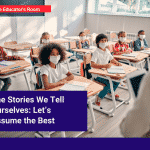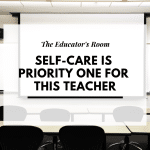Isolated Students, Exhausted Teachers and a Call for a Familiar Face
Have you signed up for The Educator’s Room Daily Newsletter? Click here and support independent journalism!
According to Daniel Malcom at the National Library of Medicine, current trends show that young people are feeling increased levels of loneliness and isolation. This directly correlates with feelings of community and closeness to the classroom. If we are not taking the time to address students’ mental health concerns, then the classroom environment cannot thrive.
The effects of looping with students have been widely documented. I myself have seen the benefits of looping with my students not once, not twice, but three years. I know from experience that looping needs to have a stronger presence in this post-pandemic world. Now more than ever, we need to recognize the social-emotional benefits of looping for both teachers and students.
Students Crave Connection
In a post-pandemic world, I, like many teachers, have heard the rallying cry for greater social-emotional well-being practices and training in our schools. These practices and training have become an absolute necessity to any successful school. In 2021, Richard Weissbourd et al. with Harvard Graduate School of Education conducted a nationwide study which found that “61% of young adults… feel serious loneliness”. With over half of our students feeling social isolation and loneliness, educators need to re-examine our practices and re-evaluate what is working and what is not. Without intervention, these feelings of social isolation and loneliness can lead to depression in our students.
One way students can continue to feel a sense of community coming back into school buildings is to see a familiar face in their classroom. This face can offer grounding for a student as well as established routines. Weisbourd et al. state, “About half of the identified lonely students in our survey… reported that no one in the past few weeks had taken more than just a few minutes to ask how they are doing in a way that made them feel generally cared for.” This startling statistic shows that students are craving teachers to care about their needs in a genuine capacity. A teacher with a pre-established relationship with the student is better equipped to make the student feel cared for. An established community is the key to students feeling comfortable opening up to their peers and teachers. It also is the key to a teacher being able to converse with a student in a way that they will feel genuinely cared for.
The Teacher Burnout Crisis
With many of our students feeling this way, it becomes even clearer why teacher burnout is at a high level. The Washington Post has recently commented on this in their piece on the national teacher shortage. We expect teachers to navigate the curriculum and improve test scores. But to achieve that, teachers have to address the social-emotional needs of their students. Even as we return to the school buildings, teacher burnout rates remain drastically high. A recent Gallup poll states that “More than four in 10 K-12 workers in the U.S. (44%) say they “always” or “very often” feel burned out at work, outpacing all other industries nationally.” In my personal experiences and conversations with professionals, high expectations with less support are a primary reason educators leave the profession. While a great deal of this is attributed to academic expectations, there must be more to the story.
Looping Kept Me in the Classroom
Throughout my experience with virtual teaching, I was disheartened, to say the least. I had physical reactions to being relegated to a screen all day. I am one of those people that needs to travel away from my living space for work. I struggled greatly with a true lack of work and home-life separation. I told myself that if the following year was going to be online as well, I would change my career. I am an active person, I go to the gym daily, and I am a social butterfly. However, during the pandemic, I couldn’t bring myself to go to the gym. I saw my friends less. I needed a daily lunchtime nap to function and get through the day, which is something I have never needed before. What kept me coming back and turning my screen on were the students I had spent an entire year building relationships with in person.
Yes, like many teachers, I experienced the dreaded cameras off while teaching to a black screen. But I also had plenty of times when all cameras were on, and we would have a free-flowing discussion. My students had a stronger desire to connect to our learning community because of their pre-established relationships with their peers and me. When it was time to return to the classroom for the 3rd year in a row, I was overjoyed to be back with those same students. My mental and physical health improved, and my love for teaching came back like riding a bike. I did not enter the classroom starting fresh, I entered the classroom with momentum from previous years, and I firmly believe that coming in with momentum was what kept me moving. Getting started from a standstill was not something I was prepared to do.
Looping Can Improve Mental Health for Students and Teachers
Taking on a high level of social-emotional needs can be draining. And these demands have skyrocketed in recent years. We now have a system that expects teachers to reach curricular achievements but limits their ways of addressing students’ social-emotional needs. That leads to feelings of hopelessness and frustration. Teachers who genuinely care for their students are struggling to do so because they do not have the time to establish relationships.
I do not think that looping alone will solve the teacher shortage. Teachers thrive on the relationships they are able to create with their students. If we can normalize the option of looping and allow teachers more time to build those relationships, job satisfaction could increase. The social-emotional well-being of our students is at the forefront of our minds. But if we do not prioritize the social-emotional well-being of our teachers, we are creating an environment that does not inspire our educators. Inspired educators create successful students.
I believe that a beacon of light that shines through, as it always does in education, is the face of a familiar teacher. As we face unprecedented social-emotional needs for students and teacher burnout, we cannot afford to start each year from scratch. Looping can provide the strong foundation that students and teachers need to thrive in difficult times.

My name is Adam Howard and I am an educator in Montgomery County Public Schools Maryland. I am currently working in a middle school as the 6th Grade Team Leader, Alternative Program Teacher and the Restorative Justice Leader. I have been a teacher and team leader for 3rd, 4th and 5th grade at a Title 1 Dual Language Elementary School as well. In my current position I aspire to mentor and help students navigate the transitional time of their life that is middle school. For more on my educational journey follow me on Twitter @teachkindling.
Editor’s Note: If you enjoyed this article, please become a Patreon supporter by clicking here.







